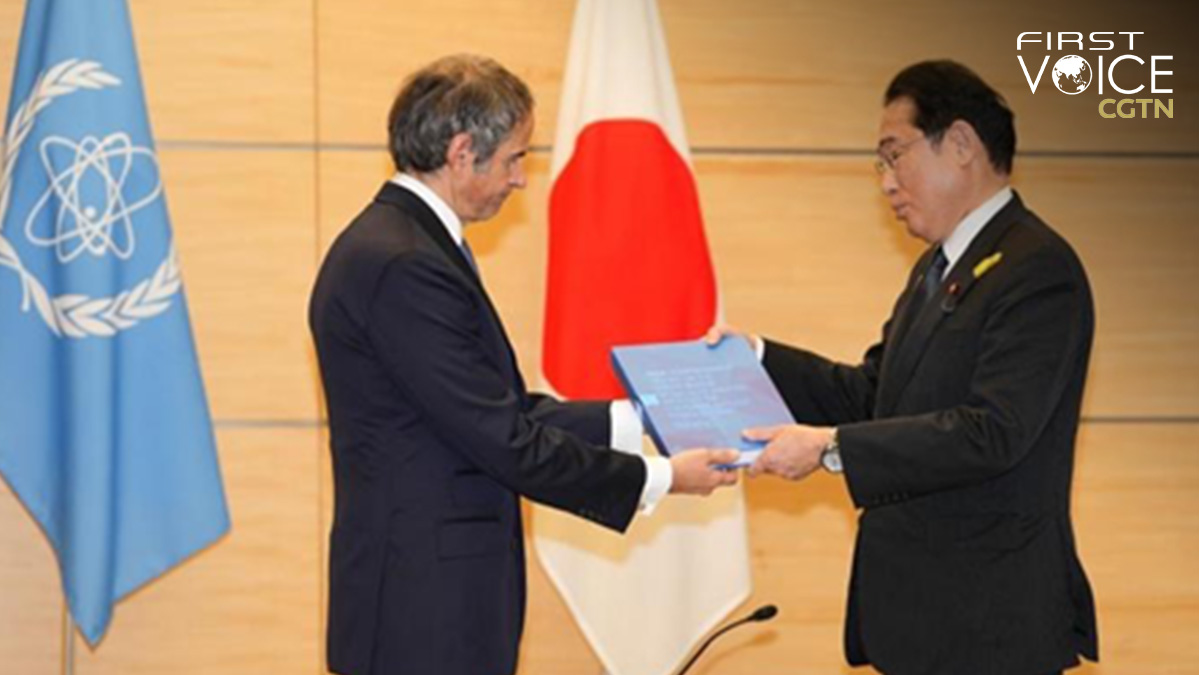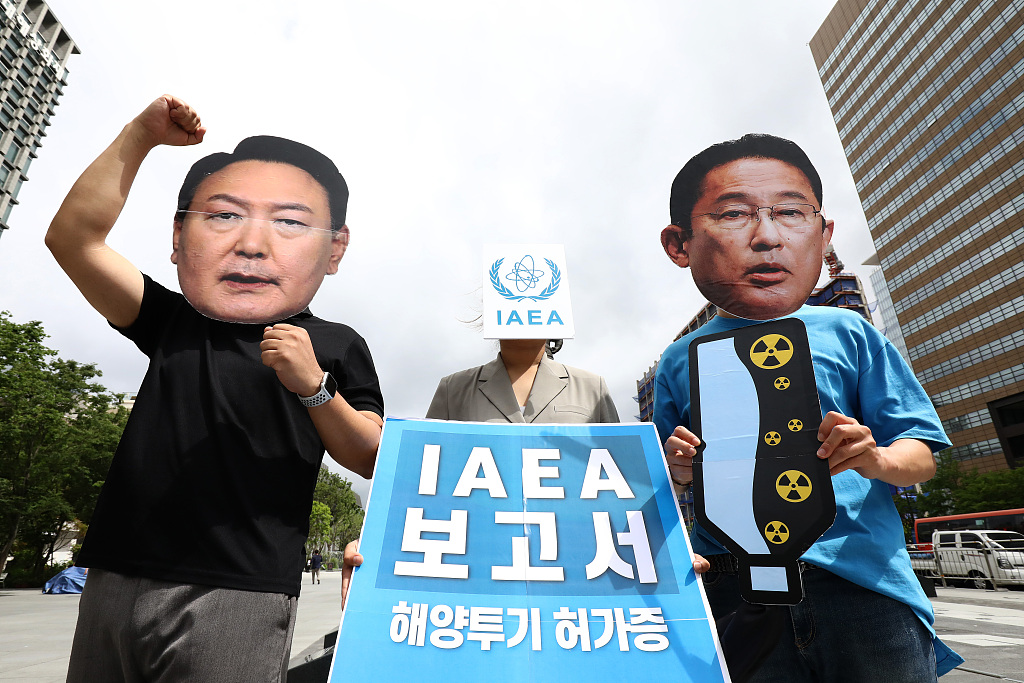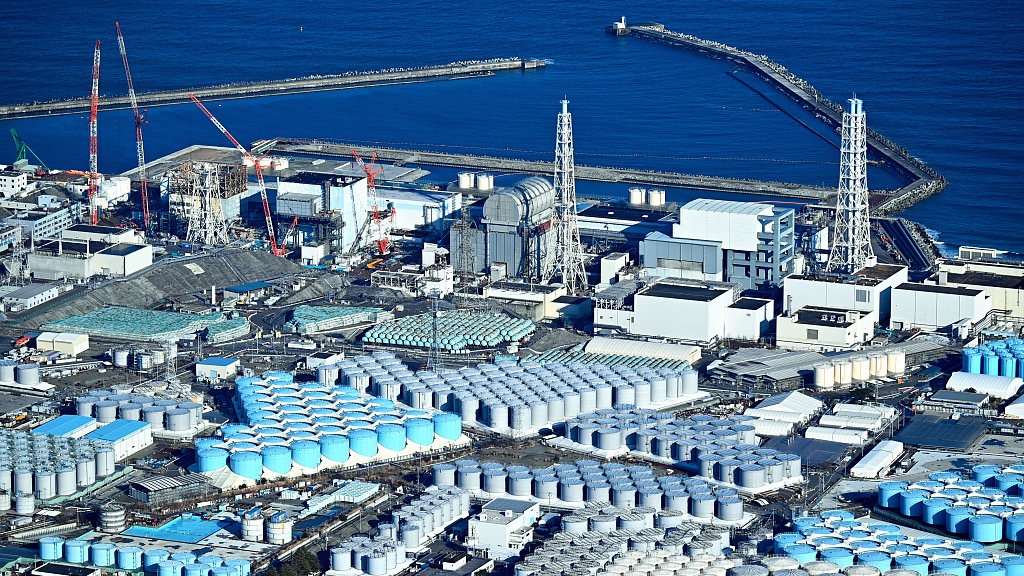
The International Atomic Energy Agency (IAEA) Director General Rafael Grossi (L) delivers safety review report on Japan's plan to release nuclear-contaminated water from the crippled Fukushima Daiichi nuclear power plant into the sea to Japanese Prime Minister Fumio Kishida in Tokyo, Japan, July 4, 2023. /Xinhua
The International Atomic Energy Agency (IAEA) Director General Rafael Grossi (L) delivers safety review report on Japan's plan to release nuclear-contaminated water from the crippled Fukushima Daiichi nuclear power plant into the sea to Japanese Prime Minister Fumio Kishida in Tokyo, Japan, July 4, 2023. /Xinhua
Editor's note: CGTN's First Voice provides instant commentary on breaking stories. The column clarifies emerging issues and better defines the news agenda, offering a Chinese perspective on the latest global events.
On July 4, the International Atomic Energy Agency (IAEA) Director-General Rafael Grossi delivered a safety review report on Japan's plan to release nuclear-contaminated water from the crippled Fukushima Daiichi nuclear power plant into the sea to Japanese Prime Minister Fumio Kishida. According to Japanese media reports, after receiving the report, Kishida immediately announced that the date of discharge will be set in August.
This assessment report is like a "passport" for the discharge of Fukushima nuclear-contaminated water into the sea, giving the Japanese government the "endorsement" of official agencies for the long-planned discharge plan.
But the IAEA, which was formally established in 1957, is in fact just an international organization that promotes the safe, secure, and peaceful use of nuclear technology. Existing international documents, including the Statute of the IAEA, indicate that the international community has never given the IAEA any authority to approve or decide on the discharge of radioactive waste.
In fact, after reading the report carefully, it is not difficult to find that the Japanese government selectively avoided the disclaimer in the report that said "the release of the treated water stored at Fukushima Daiichi Power Station is a national decision by the Government of Japan and that this report is neither a recommendation nor an endorsement of that policy." It is not difficult to understand Japan's intention.

South Korean protesters wearing masks of Japanese Prime Minister Fumio Kishida and South Korea's President Yoon Suk-yeol during a protest against the Japanese government's decision to dump radioactive wastewater from the damaged Fukushima nuclear power plant into the Pacific, Seoul, South Korea, July 5, 2023. /CFP
South Korean protesters wearing masks of Japanese Prime Minister Fumio Kishida and South Korea's President Yoon Suk-yeol during a protest against the Japanese government's decision to dump radioactive wastewater from the damaged Fukushima nuclear power plant into the Pacific, Seoul, South Korea, July 5, 2023. /CFP
So, is it really scientific for the content of the nuclear sewage mentioned in the report that it "conforms to international safety standards" and that "the impact of the discharged water on people and the environment is negligible?"
Shaun Burnie, a German expert on the nuclear environment, pointed out that Tokyo Electric Power Company (TEPCO) had done a clever job in the samples it provided for testing, measuring only 20 percent of all the water in the nuclear sewage storage tank, and providing only 25 liters before dilution as samples to third parties. However, the Fukushima Daiichi nuclear power plant has a total of more than 1.3 million tons of nuclear-contaminated water, and the sample size is unbelievably small.
According to Liu Senlin, a Chinese expert who participated in the technical work of the IAEA assessment, from a procedural point of view, although the IAEA Secretariat had solicited expert opinions from the technical working group on the draft report, there was actually very little time left for experts to evaluate.
The IAEA did not have enough time to conduct arguments, nor did it re-discuss with various experts after receiving feedback. Reuters reported on July 7 that Grossi also hinted that the expert team had differences on the content of the report.
Professor Ferenc Dalnoki-Veress, an American nuclear physicist who has conducted four-year data surveys on Fukushima nuclear sewage, pointed this out when talking about nuclear sewage data: "The biggest problem is that we don't have any data at all. It is impossible to know what the contaminated water in the tank is, and the data on that water is incomplete, inaccurate and inconsistent."
Arjun Makhijani, director of the U.S.Institute for Energy and EnvironmentResearch, also said that nuclear sewage contains more types of radioactive substances than announced. Due to insufficient processing capacity and failure of multi-nuclides removal equipment, other nuclides are likely to be discharged at the same time except tritium. However, the sea discharge plan formulated by the Japanese government has so far failed to provide sufficient scientific and factual basis on this issue. It is difficult to estimate what impact the sea discharge behavior will have on human beings.

Damaged reactors and tanks store treated radioactive water are seen at TEPCO's Fukushima Daiichi Nuclear Power Plant in Okuma, Fukushima, Japan, January 19, 2023. /CFP
Damaged reactors and tanks store treated radioactive water are seen at TEPCO's Fukushima Daiichi Nuclear Power Plant in Okuma, Fukushima, Japan, January 19, 2023. /CFP
12 years ago, Japan received sympathy and support from all over the world because of the Fukushima nuclear accident. 12 years later, Japan chose to transfer the risk of nuclear pollution to all mankind.
Fukushima nuclear sewage is an unprecedented major crisis facing human society. It requires the international community to negotiate and deal with it in a scientific, safe, and transparent manner, rather than simply "cleaning it out" in consideration of economic costs.
As a signatory to a series of international laws and treaties such as the United Nations Convention on the Law of the Sea, the Convention on Nuclear Safety, and the Joint Convention on the Safety of Spent Fuel Management and the Safety of Radioactive Waste Management, Japan's actions have seriously deviated from its international legal obligations.
If the Japanese government is allowed to go its own way and discharge nuclear sewage into the sea on such a large scale, then the world may have opened a Pandora's box full of unknown disasters.
(If you want to contribute and have specific expertise, please contact us at opinions@cgtn.com. Follow @thouse_opinions on Twitter to discover the latest commentaries in the CGTN Opinion Section.)